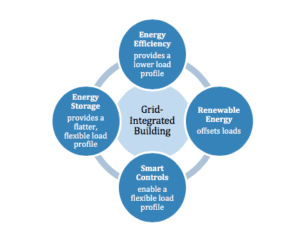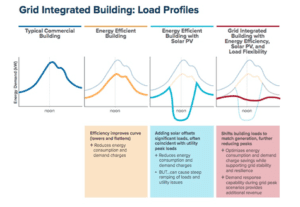
Grid-Integrated Buildings: A Profitable Linchpin to Decarbonization
I was recently asked by the director of sustainability of a major corporation, “What’s beyond LEED Platinum and net zero energy?”
I was excited by her question, not only because is it the same question that we are grappling with at Rocky Mountain Institute, but because it is coming from the building industry itself—the very group of folks who are in the best position to make the solution a reality.
Here’s the answer I shared: grid-integrated buildings
Most building owners and operators are unaware of the financial opportunity and uninformed about the technical solutions available right now to take advantage of grid-integrated systems.
In addition, building owners and utilities are separately pursuing high-performance energy innovations. These efforts are insufficiently integrated and are not cost and emissions optimized. Electric utilities in the United States plan to invest more than $1 trillion in traditional supply-side grid infrastructure—generation, transmission, and distribution—over the next 15 years. These investments are extremely wasteful since demand-side investments can mitigate supply-side investments at 20 percent of the cost. Without intervention, uninformed utility investments will persist.
We all live and work in buildings. In fact, we spend approximately 90 percent of our time in them. And, while energy efficiency has been the mantra for decades, and savvy building owners are adding renewables such as solar at a nice clip, if we don’t start connecting buildings as interactive parts of the larger energy grid, we will have won the battle but lost the war.
Energy grids in the United States have a growing share of intermittent resources, such as wind and solar, which makes load management a critical lever for grid operators. At the same time, demand peaks are increasing, even in net-zero energy buildings, making real-time energy management at the building level more important and valuable than ever to balance supply and demand.
The Vision
To meet our climate goals, buildings need to use less energy and simultaneously enable a low-carbon grid by avoiding high and erratic peak energy demands. Why? Because buildings are the linchpin to a decarbonized grid—and the grid is only as green as buildings enable it to be.
Figure 1: Grid-integrated buildings have a holistically optimized blend of energy efficiency, energy storage, distributed energy generation, and load flexible technologies/smart controls. This results in a lower, “flatter,” more flexible energy load profile. This, in turn, delivers a more resilient and productive building, optimizes capital investments, reduces operating costs, and provides access to new revenue. At the campus or community scale, additional strategies such as microgrids and district energy systems may also be advantageous. 
As responsive assets, buildings can dynamically interact with the power grid and ramp energy use up or down depending on the cost or carbon intensity of the utility generation source. This helps utilities to decarbonize the electricity system in time to meet IPCC goals, ensuring the balanced, flexible supply and demand of high levels of renewables and resulting in resilient cities, communities, and regions.
To do this, grid-integrated buildings should leverage an optimized suite of measures, including (1) energy efficiency, (2) renewable energy, (3) energy storage, and (4) load flexibility. This results in a smoother, more flexible energy load profile that delivers operational cost savings, resiliency, and access to new revenue.
The following graphs depict representative daily building load profiles for an office building. The first shows a typical commercial building load profile with a midday peak demand. The second scenario shows the benefit that energy efficiency provides by lowering the load profile overall and reducing energy use and demand. The third scenario is an efficient building with on-site solar PV generation.
The last scenario shows an optimized blend of energy efficiency, solar PV, energy storage, and load flexibility, which delivers a much lower and flatter load profile. And, with battery storage and load-flexing smart controls, it enables the building to respond to grid signals. This can provide revenue potential under current rate structures and enable buildings to adjust to future rate structures so they can continue to provide grid benefits and financial return to owners.
Note that a typical zero-energy building that balances energy use and generation over the course of the year still may have dramatic peak demands (e.g., when cloud cover reduces PV production). The under-recognized consequences of zero-energy buildings on the utility side include steep ramping up or down of generation and curtailment when the PV is overproducing.
A major challenge to decarbonizing buildings is that the carbon intensity of energy from the grid varies moment to moment, and in some regions, that variation can be significant. For example, in the California grid (CA ISO) there is a 96 percent difference in emissions between the most carbon-intensive and least carbon-intensive hours of the year. In the New York Grid (NY ISO) the variation is around 25 percent, whereas in the Midwest (the PSCO grid), the variation is closer to 11 percent. (These figures are based on 2017 annual data, which will also change as coal plants are retired and more solar, wind, and natural gas take their place.)
The bottom line is that enabling buildings to provide load flexibility is paramount. That enables buildings to shift loads and respond to peaks as the grid shape changes daily, seasonally, and annually.
Grid-Interactive Buildings Can Generate Income
Should building owners and operators bother with this approach? In a word, yes!
Building owners can unlock several significant revenue streams by operating their buildings to coordinate with the electricity grid. These will vary depending on different conditions, such as utility rate structures, building opportunities, and solar resources.
Typical financial benefits for the building owner include:
- Energy charge reduction. Lower energy use results in lower energy bills.
- Demand charge reduction. Demand charges are based on the highest rate of electrical use during a billing period. Grid-interactive buildings that avoid these peaks result in direct, reliable cost savings on utility bills. (This is typically the largest source of financial value today.)
- Selling electricity back. In areas where utilities support net metering, surplus electricity can be sold back into the grid. In areas with time-of-use rates, building operators can operate their buildings so that electricity is purchased when electricity costs are low and sold when it is most valuable.
- Capacity/demand response. By participating in a utility’s demand-response programs, buildings respond to a utility signal to reduce electricity use at a specific time allowing building owners to receive a payment from the utility.
- Frequency regulation. In the group of “ancillary services” provided in the open market management of the grid, frequency regulation has the highest value. Electricity storage has the capability for doing the job in milliseconds, generating a payment to the building owner for regulation services benefiting the grid.
- Resilience, the avoided cost of interruption, is a financial benefit that can vary greatly depending on the circumstance. The NREL report Valuing the Resilience Provided by Solar and Battery Energy Storage Systems shows that placing a value on the losses incurred from grid disruptions can make a PV and storage system a fiscally sound investment. Another report valued the cost per hour lost for various building types, including a primary school ($2,368), large hotel ($5,317), and large office ($14,365). At these rates, battery storage becomes very attractive.
Even accessing a few of these revenue streams can dramatically change the cost-effectiveness of operating a building to optimize its grid interactions. Engaging more of them can change the paradigm of operating a building, transforming it from a cost center into a revenue stream.
Proof of point occurred over Labor Day 2018 in Boston. An emergency event was called due to higher-than-expected electricity usage and an outage at the highest-capacity power plant in Massachusetts, Mystic Generating Station. In this instance, the utility and grid operators were able to avoid service interruptions, due to the flexibility and rapid response of virtual power plants, which was in large part buildings participating in demand response. Grid integrated buildings became heroes.
This is an exciting time. Grid-integrated buildings can create tangible value across key stakeholder groups, including utilities, grid operators, building owners, and building occupants. Recognizing these benefits can align incentives and provide financial rewards. Optimization of the building and its grid interaction is good for business—and results in a better environment for us all.
